Society of Nuclear Medicine, Reston, VA, 1995, $30 for SNM members; $42 for non-members
Now in its third edition, this primer is a very readable and lucid overview of nuclear imaging with SPECT technology. It is highly recommended as an introductory text on SPECT.
Divided into three main parts (Fundamentals, Instrumentation, and Clinical Applications), the book addresses the basic subjects of SPECT imaging, but adds technical information not readily found in other basic textbooks, or for that matter, in journal articles.
I particularly liked Mr. English’s discussion on acquisition parameters, and the emphasis on the importance of collimators. He uses a conversational writing style that makes for easy and effortless reading. The information is up-to-date, balanced in opinion, and explains issues in a non-technical manner. The mathematics is left for the appendices.
The author is very good at clarifying for the reader the difference between the practical and the academic by highlighting instances where action is required, rather than dwelling on the theories of SPECT imaging. This is often a struggle for people new to the field and a clear explanation is often lacking in other texts.
The book has a few shortcomings. On page 18, the reference to stroke leaves out MRI as a modality for urgent identification. On page 64, the expression of noise as a percentage was unclear to this reader (but the graphs on the concepts of filters are great!).
On page 100 and in the glossary, there is no mention of DICOM communication; in the section on networking, transfer standard is left out. Setting up network nodes to allow for patient workflow, storage, transfer to the physician reading room or independent workstation synthesis with CT or MRI, or even just film printing nowadays often means a basic understanding of the DICOM structure. The glossary, table summaries, and content index are adequate. More reference data might have been included.
By William Pavlicek, Ph.D.AuntMinnie.com contributing writer
February 28, 2003
William Pavlicek, Ph.D., is the staff diagnostic physicist and radiation safety officer, department of radiology, at the Mayo Clinic Scottsdale in Arizona. He has been an instructor in nuclear medicine technology.
If you are interested in reviewing a book, let us know at [email protected].
The opinions expressed in this review are those of the author, and do not necessarily reflect the views of AuntMinnie.com.
Copyright © 2003 AuntMinnie.com




















